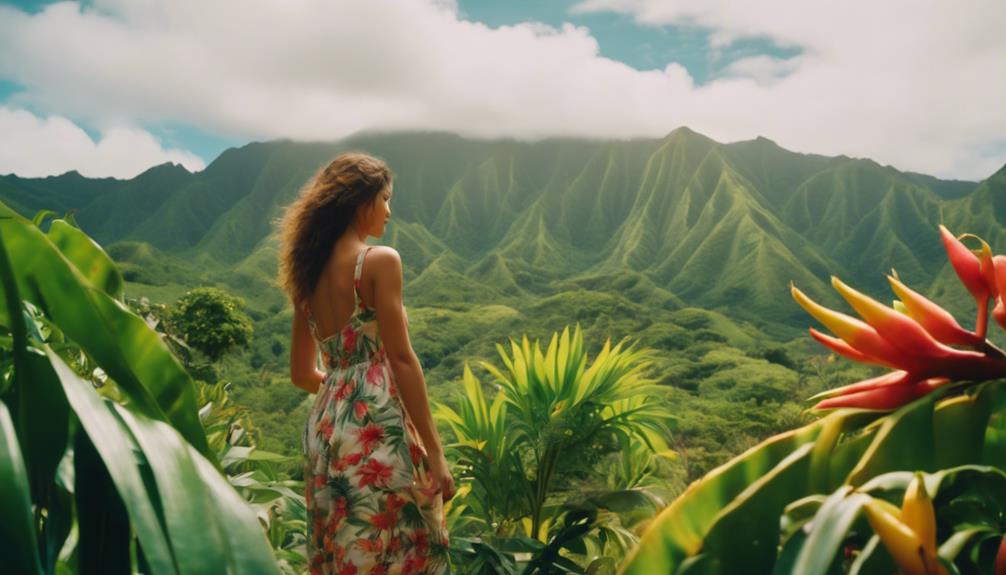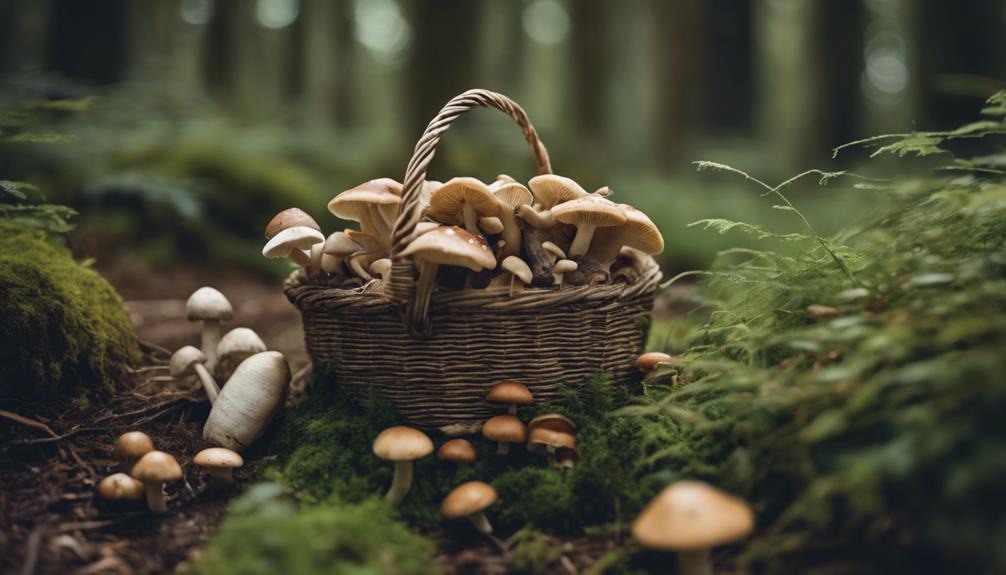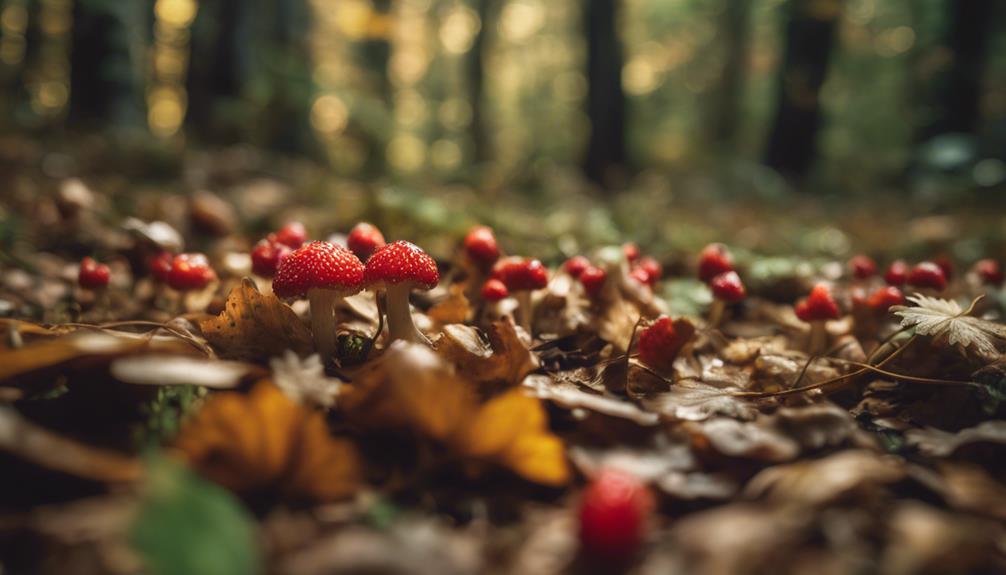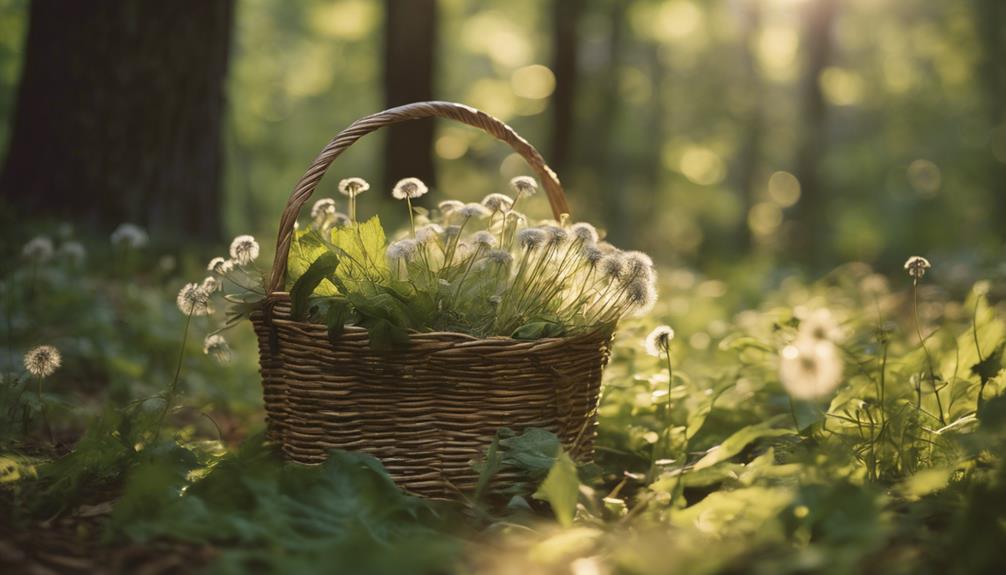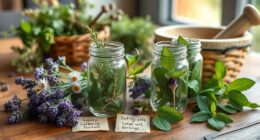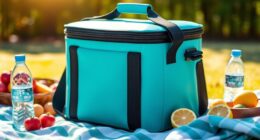You're about to uncover the secrets of Hawaii's exotic wild foods! Explore the islands' lush landscapes and discover unique fruits like starfruit, noni, and Java plum. Learn about medicinal plants like noni, kukui, and ti, with their remarkable healing properties. Forage for native edibles like breadfruit, seagrape, and Chinese hibiscus, and experience the rich cultural heritage of Hawaii. From wild greens to coastal delights, island spices, and uncommon edible flowers, get ready to savor the flavors of Hawaii's natural bounty. As you venture deeper, you'll uncover more tropical treats waiting to be discovered.
Key Takeaways
- Explore Hawaii's tropical landscapes to forage for exotic fruits like starfruit, noni, and Java plum, understanding their habitats and ripeness.
- Learn to identify and harvest wild greens like amaranth, watercress, and purslane, adding fresh flavors to your diet.
- Discover medicinal plants like noni, kukui, and ti, which offer remarkable healing properties and can be incorporated into daily routines.
- Respect sustainable foraging practices, avoiding overharvesting, ecosystem damage, and introducing invasive species to preserve Hawaii's natural environment.
- Enjoy unique flavors and textures from island delights like seagrape, Chinese hibiscus, and tropical leafy greens, which can elevate culinary creations and connect you to Hawaii's cultural heritage.
Exploring Hawaii's Wild Edibles
As you venture into Hawaii's lush landscapes, you'll discover a treasure trove of wild edibles waiting to be foraged. Amidst the tropical scenery, you'll find an array of edible plants and flowers that will tantalize your taste buds.
Kukui, for instance, offers oily, nutty roasted nuts and inamona for flavoring. Breadfruit, commonly found near ancient Hawaiian settlements, provides edible white flesh when cooked, but be sure to avoid eating it raw, as it can cause nausea.
In coastal areas, you'll stumble upon Seagrape, which yields ripe, purple-red fruits perfect for raw consumption or making jelly and wine. Ti, thriving in wet areas, provides leaves for food wrapping and sweet, starchy rhizomes for roasting in luau.
And, don't miss the vibrant Chinese Hibiscus, whose colorful, edible flowers can be consumed raw or cooked, and surprisingly, last until evening without wilting. These wild edibles are just a few of the many treasures Hawaii has to offer.
Foraging for Exotic Fruits

As you venture into Hawaii's tropical landscapes, you'll discover a world of exotic fruits waiting to be picked. From starfruit to noni and Java plum, these unique flavors are ripe for the taking.
Now, let's explore the best tropical fruit hotspots, learn how to identify ripe fruits, and uncover fruitful foraging tips to make your culinary adventures unforgettable.
Tropical Fruit Hotspots
Venturing into Hawaii's lush tropical landscapes, you'll stumble upon fruit hotspots teeming with exotic delights like starfruit, noni, and Java plum. These edible treasures are scattered throughout the islands, waiting to be discovered.
As you go foraging, keep in mind that Hawaii's fruit trees are a mix of endemic, indigenous, and alien species introduced post-late 1700s. Be aware of the impact of alien species on native Hawaiian plants and ecosystems, and always consult with an expert before consuming wild plants.
Tropical fruit hotspots in Hawaii offer a unique culinary experience and a deeper connection to the islands' natural environment. You'll find a diverse range of fruits, each with its own unique flavor and texture. From the sweet and tangy starfruit to the earthy and slightly bitter noni, every bite is an adventure.
Ripe for the Picking
You'll find yourself surrounded by a rainbow of colors and enticing aromas as you set out on a foraging adventure for exotic fruits in Hawaii's lush landscapes. As you wander through the tropical paradise, you'll stumble upon an array of wild foods, each bursting with flavor and nutrients.
Exotic fruits like starfruit, noni, and Java plum are popular foraging finds in Hawaii. Starfruit, with its unique star-shaped cross-section, is a tropical fruit that's rich in vitamin C and perfect for snacking on the go. Noni, a native Hawaiian fruit, may have a strong odor, but its potential health benefits make it a prized find. Java plum, sweet and tangy, is commonly used in jams and jellies, making it a delicious addition to your foraging haul.
Foraging for these exotic fruits offers a taste of Hawaii's diverse and flavorful natural bounty. As you forage, you'll discover the thrill of uncovering hidden gems in the wild, and the satisfaction of enjoying a fresh, nutrient-rich snack.
Fruitful Foraging Tips
Before you start foraging for exotic fruits in Hawaii, acquaint yourself with the fruits' appearances, growth habits, and habitats to guarantee a successful and safe foraging experience. Familiarizing yourself with the characteristics of each fruit will make sure you identify them correctly and avoid any lookalikes.
Here's a quick guide to get you started:
| Fruit | Description |
|---|---|
| Starfruit | Yellow or green, star-shaped, sweet and tangy |
| Noni | Small, yellowish-white, pungent smell, potential health benefits |
| Java Plum | Purple or black, sweet and slightly tangy when ripe |
As you venture into Hawaii's wilderness, keep in mind that these fruits grow in different environments. Starfruit and noni thrive in tropical climates, while Java plum prefers well-drained soil and partial shade. By understanding their growth habits and habitats, you'll increase your chances of finding these fruits in the wild. Happy foraging!
Medicinal Plants of the Islands

As you explore the islands, you'll discover a treasure trove of medicinal plants, each with its unique healing properties.
You'll learn about Healing Island Herbs, like Noni and Java Plum, which have been used for centuries to prevent and treat various ailments.
Healing Island Herbs
Among the lush island landscapes, Hawaiian healing herbs like Noni, Kukui, and Ti have thrived for centuries, prized for their remarkable medicinal properties. As you forage through the islands, you'll discover the rich history and benefits of these traditional remedies.
You'll find that Noni, for instance, is believed to have anti-inflammatory and immune-boosting properties when consumed, making it a valuable addition to your health regimen.
Kukui, on the other hand, is renowned for its soothing effects on the skin, making it a popular ingredient in traditional remedies for skin conditions.
Meanwhile, Ti leaves have been utilized in traditional Hawaiian medicine for their antiseptic and wound-healing properties, proving invaluable in treating wounds and promoting healthy skin.
By incorporating these healing island herbs into your daily routine, you'll be tapping into the ancient wisdom of native Hawaiians, who've relied on these natural remedies for generations.
As you explore the islands, take note of these remarkable plants and their incredible healing potential.
Tropical Plant Remedies
You'll discover that the islands are also home to a variety of tropical plant remedies that have been used for centuries to promote overall well-being. These medicinal plants, such as Noni, Kukui, and Ti, have been traditionally used for healing purposes. You'll find that they offer natural remedies for a range of ailments, with properties that can aid in digestion, stress relief, and overall well-being.
The Ti plant, for instance, is used in Laau Laupaau, a traditional Hawaiian herbal medicine practice for treating various health issues. Noni, despite its strong smell, is known for its potential health benefits when consumed in processed forms like juices and supplements. Kukui nuts, when crushed and roasted, produce inamona, which is used as a flavoring and can also be beneficial for certain health conditions.
Native Hawaiian Edible Plants

Venturing into Hawaii's lush landscapes, you'll discover a variety of native edible plants waiting to be foraged and savored. As you explore, keep an eye out for these five native Hawaiian edible plants:
- Kukui: Growing in low to middle elevation, its oily, nutty roasted nuts are perfect for flavoring and lighting torches.
- Breadfruit: Found near Hawaiian settlements, its edible white flesh is delicious when cooked, but beware – raw fruits can cause nausea.
- Seagrape: Thriving in coastal areas, it offers edible purple-red fruits, nectar for honeybees, and pale, spicy honey.
- Ti: Growing in wet areas, use its leaves for cooking in imu, sweet rhizomes for roasting, and enjoy it edible after baking.
- Chinese Hibiscus: Boasting colorful, edible flowers lasting until evening, use them in teas for digestion and stress relief.
These native Hawaiian edible plants aren't only delicious but also offer a glimpse into the islands' rich cultural heritage. By foraging for these wild foods, you'll experience the authentic flavors and traditions of Hawaii.
Wild Greens for Salads

As you start exploring wild greens for salads, you'll discover a world of Island Bitter Greens and Tropical Leafy Delights that will elevate your salads to the next level.
You'll learn about the unique flavors and textures of wild greens like sows thistle, hares lettuce, and amaranth, which are commonly found in Maui.
Island Bitter Greens
Among the lush landscapes of Hawaii, one wild edible gem stands out for its unique flavor and versatility: Island Bitter Greens. As you explore the islands, you'll discover these wild edible plants, such as sows thistle and hares lettuce, growing freely.
Island Bitter Greens offer a depth of flavor and texture that's crucial for adding excitement to your salads or cooked dishes.
To make the most of these wild greens, it's important to properly identify them to guarantee they're safe for consumption. Not only will you be showcasing local, sustainable ingredients, but you'll also be continuing a tradition that dates back to ancient Hawaiians, who used Island Bitter Greens as part of their herbal medicine, Laau Laupaau.
Here are some key benefits to foraging for Island Bitter Greens:
- Add unique flavors and textures to your dishes
- Support local, sustainable ingredients
- Continue a traditional Hawaiian practice
- Elevate your culinary creations with exotic flavors
- Explore the rich cultural heritage of Hawaii through food
Tropical Leafy Delights
When crafting the perfect tropical salad, you'll want to head outdoors to forage for wild greens like sows thistle, hares lettuce, and amaranth, which grow abundantly in Maui's lush landscapes. These leafy delights will add a fresh twist to your salad, and they're packed with nutrients too!
You can also experiment with ginger stalks and Chayote Squash for unique flavors and textures. Did you know that incorporating fresh-picked herbs into your salad can have healing properties, just like in traditional Hawaiian herbal medicine practice, Laau Laupaau?
To make sure you're picking safe greens, understanding taxonomic families to distinguish between edible and toxic plants is crucial. By incorporating wild greens like ginger, leafy greens, and chayote squash into your salad, you'll experience a true tropical twist.
Tropical Fruit Foraging Spots

In the lush tropical landscape, you'll find an abundance of exotic fruits waiting to be foraged in hidden spots, each with its unique characteristics and uses. As you venture into the tropical paradise, you'll discover a world of flavors and textures that'll tantalize your taste buds.
Here are some of the tropical fruit foraging spots you shouldn't miss:
- Kukui trees: Producing roasted nuts with an oily, nutty flavor, these trees thrive in low to middle elevation, in moist to mesic areas.
- Breadfruit: Found in tropical lowland areas near ancient Hawaiian settlements, the white flesh of this fruit becomes edible and delicious when cooked.
- Seagrape plants: Flourishing in coastal areas, these plants bear ripe, purple-red fruits that can be enjoyed raw or used in jelly and wine.
- Ti plants: Growing in wet to mesic areas at low to middle elevations, these plants offer leaves for food wrapping in imu cooking and sweet, starchy underground rhizomes.
- Chinese Hibiscus flowers: Colorful and edible, these flowers last until evening without wilting, making them perfect for teas and adding vibrant flavor to dishes.
Get ready to indulge in the rich flavors of Hawaii's tropical fruits!
Hawaii's Coastal Edible Delights

As you make your way to Hawaii's coastal areas, you'll discover a variety of edible delights that thrive in the salty air and sea spray.
One of the most notable coastal treats is the seagrape, a salt-tolerant plant that produces ripe, purple-red fruits that are edible raw or used in making jelly and wine. You can easily identify and harvest the fruits, as each one contains a single hard seed.
The flowers of the seagrape plant are also a treat, attracting honeybees for nectar, which results in a pale and spicy Sea Grape honey. When you try the ripe fruits fresh, you'll experience a unique taste of Hawaii's coastal edible delights.
The seagrape's ability to thrive in coastal environments makes it a standout among other plants that struggle to grow in these conditions. As you explore Hawaii's coast, be sure to keep an eye out for this delicious and resilient plant.
Foraging for Island Spices

Delving into Hawaii's lush landscapes, you'll uncover a treasure trove of island spices that will elevate your culinary adventures. Foraging for island spices adds a cultural and culinary dimension to exploring Hawaii's natural bounty.
You'll discover unique flavors and aromas in kukui, ti, and Chinese hibiscus, which are just waiting to be incorporated into your dishes.
Here are a few island spices to look out for:
- Kukui: Roast the nuts for a nutty flavor, perfect for traditional dishes like inamona.
- Ti: Use the leaves for cooking in imu, and the rhizomes for a sweet and starchy component.
- Chinese Hibiscus: Enjoy the edible flowers raw or cooked, or use them to make teas for digestion and stress relief.
- Cultural Significance: Foraging for island spices connects you to Hawaii's rich cultural heritage.
- Elevate Your Cooking: Incorporate these island spices into your recipes to add depth and complexity to your dishes.
As you explore Hawaii's lush landscapes, remember to respect the land and its resources, and happy foraging!
Uncommon Edible Flowers

Beyond island spices, you'll find an array of uncommon edible flowers waiting to be discovered, adding a pop of color and flavor to your culinary creations.
One of the most versatile and exotic options is the Chinese hibiscus flower. Not only do they add a vibrant splash of color to any dish, but they also offer a unique taste experience. You can consume them raw or cooked, making them a great addition to salads, soups, or as a garnish.
Dried Chinese hibiscus flowers can also be used in teas, which are said to aid in digestion and stress relief. In Hawaiian cuisine, edible flowers like Chinese hibiscus are often used to add a touch of elegance and whimsy to dishes.
As a garnish, they're unparalleled, adding a delicate beauty to any plate. With their long-lasting petals that remain fresh until evening, Chinese hibiscus flowers are a popular choice for chefs and foodies alike.
Sustainable Foraging Practices

When foraging for exotic wild foods, you're not just searching for rare ingredients – you're also responsible for preserving the environment that makes them thrive. As you venture into the Hawaiian wilderness, it's crucial to adopt sustainable foraging practices to guarantee the long-term health of the ecosystem.
Here are some key principles to keep in mind:
** Only harvest what you need, minimizing your impact on the environment.
** Respect plant life by avoiding overharvesting and damaging the ecosystem.
Leave no trace** by not disrupting the natural habitat or introducing invasive species.
Follow local regulations and guidelines to uphold responsible foraging**.
** Consider the long-term effects of foraging on plant populations and biodiversity.
Frequently Asked Questions
How to Forage for Wild Food?
You'll master wild food foraging by identifying plants correctly, exercising caution, and avoiding contaminated sources; then, get creative with your finds in teas, garnishes, and dishes, showcasing local flavors and sustainable ingredients.
How Do Beginners Do Forage?
You start by building a strong foundation, just like a tree grows from a single seed, and begin by learning to identify common edible plants, taking guidance from local experts, and prioritizing safety in your foraging journey.
What Edible Plants Are Native to Hawaii?
You're wondering what edible plants are native to Hawaii? Well, you're in luck! You'll find Kukui, Breadfruit, Seagrape, Ti, and Chinese Hibiscus growing wild, offering a range of tasty and nutritious options to forage and enjoy!
Where Is It Safe to Forage?
When foraging, you'll want to steer clear of polluted areas like highways and industrial sites, opting instead for pristine environments like forests, coastal regions, and mountains where you can find safe and edible wild foods. Always ensure you’re familiar with the plants, mushrooms, and berries in the area to avoid poisonous varieties. It’s also wise to bring along a field guide or use a trusted app to help you identify species as you forage for wild foods. Sustainable foraging practices, such as taking only what you need and leaving some behind, help preserve the ecosystem for future foragers.
Conclusion
As you wander through Hawaii's lush landscapes, remember that the islands' wild bounty is a treasure trove waiting to be discovered.
Just as a maile lei is woven from individual flowers, so too can your foraging journey be threaded together with each new discovery.
May your path be guided by respect for the land and its secrets, and may your plate be filled with the flavors of aloha.

